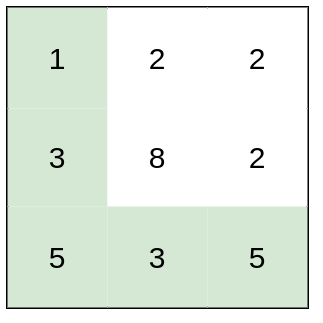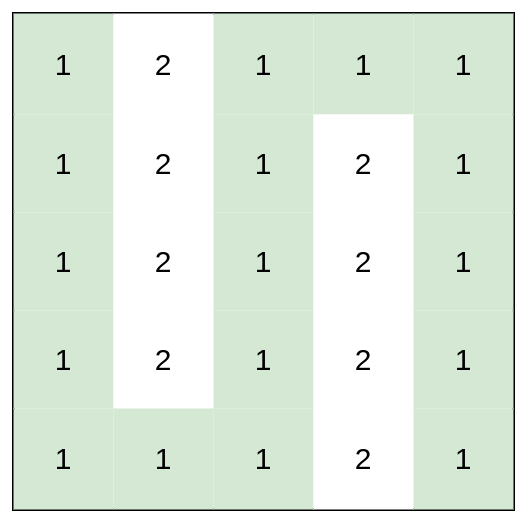mirror of
https://github.com/halfrost/LeetCode-Go.git
synced 2025-07-06 09:23:19 +08:00
170 lines
6.1 KiB
Markdown
170 lines
6.1 KiB
Markdown
# [1631. Path With Minimum Effort](https://leetcode.com/problems/path-with-minimum-effort/)
|
||
|
||
## 题目
|
||
|
||
You are a hiker preparing for an upcoming hike. You are given `heights`, a 2D array of size `rows x columns`, where `heights[row][col]` represents the height of cell `(row, col)`. You are situated in the top-left cell, `(0, 0)`, and you hope to travel to the bottom-right cell, `(rows-1, columns-1)` (i.e., **0-indexed**). You can move **up**, **down**, **left**, or **right**, and you wish to find a route that requires the minimum **effort**.
|
||
|
||
A route's **effort** is the **maximum absolute difference** in heights between two consecutive cells of the route.
|
||
|
||
Return *the minimum **effort** required to travel from the top-left cell to the bottom-right cell.*
|
||
|
||
**Example 1:**
|
||
|
||

|
||
|
||
```
|
||
Input: heights = [[1,2,2],[3,8,2],[5,3,5]]
|
||
Output: 2
|
||
Explanation: The route of [1,3,5,3,5] has a maximum absolute difference of 2 in consecutive cells.
|
||
This is better than the route of [1,2,2,2,5], where the maximum absolute difference is 3.
|
||
```
|
||
|
||
**Example 2:**
|
||
|
||

|
||
|
||
```
|
||
Input: heights = [[1,2,3],[3,8,4],[5,3,5]]
|
||
Output: 1
|
||
Explanation: The route of [1,2,3,4,5] has a maximum absolute difference of 1 in consecutive cells, which is better than route [1,3,5,3,5].
|
||
```
|
||
|
||
**Example 3:**
|
||
|
||

|
||
|
||
```
|
||
Input: heights = [[1,2,1,1,1],[1,2,1,2,1],[1,2,1,2,1],[1,2,1,2,1],[1,1,1,2,1]]
|
||
Output: 0
|
||
Explanation: This route does not require any effort.
|
||
```
|
||
|
||
**Constraints:**
|
||
|
||
- `rows == heights.length`
|
||
- `columns == heights[i].length`
|
||
- `1 <= rows, columns <= 100`
|
||
- `1 <= heights[i][j] <= 10^6`
|
||
|
||
## 题目大意
|
||
|
||
你准备参加一场远足活动。给你一个二维 `rows x columns` 的地图 `heights` ,其中 `heights[row][col]` 表示格子 `(row, col)` 的高度。一开始你在最左上角的格子 `(0, 0)` ,且你希望去最右下角的格子 `(rows-1, columns-1)` (注意下标从 0 开始编号)。你每次可以往 上,下,左,右 四个方向之一移动,你想要找到耗费 体力 最小的一条路径。一条路径耗费的 体力值 是路径上相邻格子之间 高度差绝对值 的 最大值 决定的。请你返回从左上角走到右下角的最小 体力消耗值 。
|
||
|
||
## 解题思路
|
||
|
||
- 此题和第 778 题解题思路完全一致。在第 778 题中求的是最短连通时间。此题求的是连通路径下的最小体力值。都是求的最小值,只是 2 个值的意义不同罢了。
|
||
- 按照第 778 题的思路,本题也有多种解法。第一种解法是 DFS + 二分。先将题目变换一个等价问法。题目要求找到最小体力消耗值,也相当于问是否存在一个体力消耗值 x,只要大于等于 x,一定能连通。利用二分搜索来找到这个临界值。体力消耗值是有序的,此处满足二分搜索的条件。题目给定柱子高度是 [1,10^6],所以体力值一定在 [0,10^6-1] 这个区间内。判断是否取中值的条件是用 DFS 或者 BFS 搜索 (0,0) 点和 (N-1, N-1) 点之间是否连通。时间复杂度:O(mnlogC),其中 m 和 n 分别是地图的行数和列数,C 是格子的最大高度。C 最大为 10^6,所以 logC 常数也很小。空间复杂度 O(mn)。
|
||
- 第二种解法是并查集。将图中所有边按照权值从小到大进行排序,并依次加入并查集中。直到加入一条权值为 x 的边以后,左上角到右下角连通了。最小体力消耗值也就找到了。注意加入边的时候,只加入 `i-1` 和 `i` ,`j-1` 和 `j` 这 2 类相邻的边。因为最小体力消耗意味着不走回头路。上下左右四个方向到达一个节点,只可能从上边和左边走过来。从下边和右边走过来肯定是浪费体力了。时间复杂度:O(mnlog(mn)),其中 m 和 n 分别是地图的行数和列数,图中的边数为 O(mn)。空间复杂度 O(mn),即为存储所有边以及并查集需要的空间。
|
||
|
||
## 代码
|
||
|
||
```go
|
||
package leetcode
|
||
|
||
import (
|
||
"sort"
|
||
|
||
"github.com/halfrost/LeetCode-Go/template"
|
||
)
|
||
|
||
var dir = [4][2]int{
|
||
{0, 1},
|
||
{1, 0},
|
||
{0, -1},
|
||
{-1, 0},
|
||
}
|
||
|
||
// 解法一 DFS + 二分
|
||
func minimumEffortPath(heights [][]int) int {
|
||
n, m := len(heights), len(heights[0])
|
||
visited := make([][]bool, n)
|
||
for i := range visited {
|
||
visited[i] = make([]bool, m)
|
||
}
|
||
low, high := 0, 1000000
|
||
for low < high {
|
||
threshold := low + (high-low)>>1
|
||
if !hasPath(heights, visited, 0, 0, threshold) {
|
||
low = threshold + 1
|
||
} else {
|
||
high = threshold
|
||
}
|
||
for i := range visited {
|
||
for j := range visited[i] {
|
||
visited[i][j] = false
|
||
}
|
||
}
|
||
}
|
||
return low
|
||
}
|
||
|
||
func hasPath(heights [][]int, visited [][]bool, i, j, threshold int) bool {
|
||
n, m := len(heights), len(heights[0])
|
||
if i == n-1 && j == m-1 {
|
||
return true
|
||
}
|
||
visited[i][j] = true
|
||
res := false
|
||
for _, d := range dir {
|
||
ni, nj := i+d[0], j+d[1]
|
||
if ni < 0 || ni >= n || nj < 0 || nj >= m || visited[ni][nj] || res {
|
||
continue
|
||
}
|
||
diff := abs(heights[i][j] - heights[ni][nj])
|
||
if diff <= threshold && hasPath(heights, visited, ni, nj, threshold) {
|
||
res = true
|
||
}
|
||
}
|
||
return res
|
||
}
|
||
|
||
func abs(a int) int {
|
||
if a < 0 {
|
||
a = -a
|
||
}
|
||
return a
|
||
}
|
||
|
||
func min(a, b int) int {
|
||
if a < b {
|
||
return a
|
||
}
|
||
return b
|
||
}
|
||
|
||
func max(a, b int) int {
|
||
if a < b {
|
||
return b
|
||
}
|
||
return a
|
||
}
|
||
|
||
// 解法二 并查集
|
||
func minimumEffortPath1(heights [][]int) int {
|
||
n, m, edges, uf := len(heights), len(heights[0]), []edge{}, template.UnionFind{}
|
||
uf.Init(n * m)
|
||
for i, row := range heights {
|
||
for j, h := range row {
|
||
id := i*m + j
|
||
if i > 0 {
|
||
edges = append(edges, edge{id - m, id, abs(h - heights[i-1][j])})
|
||
}
|
||
if j > 0 {
|
||
edges = append(edges, edge{id - 1, id, abs(h - heights[i][j-1])})
|
||
}
|
||
}
|
||
}
|
||
sort.Slice(edges, func(i, j int) bool { return edges[i].diff < edges[j].diff })
|
||
for _, e := range edges {
|
||
uf.Union(e.v, e.w)
|
||
if uf.Find(0) == uf.Find(n*m-1) {
|
||
return e.diff
|
||
}
|
||
}
|
||
return 0
|
||
}
|
||
|
||
type edge struct {
|
||
v, w, diff int
|
||
}
|
||
``` |